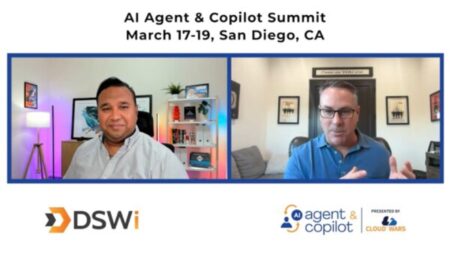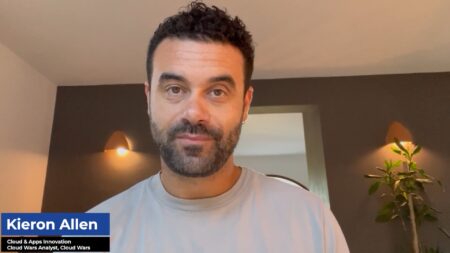
The utility industry is on the front lines of shifting economic, social, and political forces. In many ways, it’s a barometer for the challenges posed by an uncertain world where consumers experience the fallout from rising oil prices, disrupted supply chains, climate crises, and more.
Ray Alwani, Director, Business Systems Process and Strategy at ENMAX, recently spoke with Cloud Wars founder Bob Evans about how Workday Adaptive Planning’s technology helps ENMAX navigate these turbulent conditions while maintaining a strong focus on driving business results through innovation. ENMAX is a provider of electricity services, products, and solutions serving Alberta (Canada) and Maine.
Alwani explained how Workday Adaptive Planning allows ENMAX to generate what-if scenarios effectively. These scenarios took a long time to create in the past and weren’t as precise as they needed to be. “The simplest way I can explain it is that Adaptive has given us the ability to plan efficiently,” said Alwani.
“Everyday information comes in that’s going to change your financial outlook. It can be something as small as when you think you’re going to hire someone, or it could be as big as a global pandemic that’s going to change what projects you are going to execute for the year and when you’re going to execute them.”
Before deploying Workday Adaptive Planning, ENMAX found utilizing such information, and making changes in response, to be very time-consuming. One particular cost-allocation analysis took 10 hours to run. Because the job took so long, it had to be executed overnight. Yet, the data could be rendered inaccurate if a plan was updated the day after the job was run. Decisions needed to be made on whether to change the figures immediately or wait until the following month.
Using Workday Adaptive Planning, the previous 10-hour process takes about 15 minutes. With the newfound speed, flexibility, and accuracy, ENMAX can easily iterate based on what-if scenarios and quickly see the potential impact.
Adaptive Planning, Continuous Innovation
“Imagine taking anything in life that used to take a day and now takes 15 minutes,” said Alwani. “It just completely changes the conversation, and that’s the biggest thing for us.”
Time is one of the most critical business assets. Yet, the increase in processes, endpoints, users, customers, and compliance requirements means most companies have less of it.
Workday Adaptive Planning is streamlining procedures to allow businesses to focus on fine-tuning the processes they have in place and developing profitable new ones.
“To me, planning is all about iterations,” explained Alwani. “The more you can revisit the plan, the better it’s going to be, and now we have time to do more iterations of the plan.”
“We’ve done a couple of things,” continued Alwani. “The first thing we did was deploy a self-service model. Our belief was that business areas have the best information in a lot of cases to know what the future is going to look like, so we deployed a self-service model so they can access Adaptive themselves.”
“We use that extra time to actually utilize all of the information that’s available almost right up to the point where we need to report that plan to our executive team or to our board. So, because we’re able to turn things around so much quicker, the plans are more accurate and they use the information that’s actually in hand with the current time.”
Ultimately, Workday Adaptive Planning gives ENMAX the tools, time, and flexibility to drive continuous innovation. Alwani explained the three factors that must be in place to drive an innovation agenda:
- The technology that supports the business process must enable change
- There must be a team dedicated to executing change
- Multiple teams must buy in to incorporating innovative technology
Alwani explained how Workday Adaptive Planning met each of these requirements and is sparking innovation. “We’re constantly getting requests directly from our business areas to deploy new models and to change how things are working in Adaptive because they see the value, they’re the ones that are actually in there. The demand is almost endless,” he said.
Since its original implementation of Workday Adaptive Planning, ENMAX has expanded its use of the software to include:
- Capital forecasting
- Regulatory accounting and regulatory applications
- Core planning functions from across the organization
The Benefits of One Plan
“Before Adaptive, we had multiple versions of plans,” said Alwani. “We had different versions of our forecast, different versions of a budget, there wasn’t necessarily one source of truth for our plan. So, the first thing we had to get in place was the concept of one plan where our budgets and longer-term forecasts were all maintained and updated in a single plan version in Adaptive.”
This consolidation was a game-changer for ENMAX because, with a single source of truth, nobody questioned the data. It didn’t matter if a user wanted to know what was going to happen next month or in 2024, they went to the same place. There are additional data-driven benefits.
“We have the same characteristics on the data for both our actuals and our plan,” said Alwani. “So, the data that’s actually reflective of historicals, plus forward-looking, looks and feels the same, so it’s a little bit easier to interpret, and that’s been very helpful for us.”
In addition to Workday Adaptive Planning, ENMAX also uses Workday Human Capital Management and Workday Financial Management software. Alwani explained how having a single view across three applications has benefited the company.
“It’s been pretty critical for us,” he said. “A big component of our financial planning is staff related and we’ve managed to integrate our Workday HCM system with our Adaptive system so that when you’re going into Adaptive and forecasting out your staffing costs, we’re able to show users the latest and greatest data that’s in our HCM system.”
Another benefit has been communication between systems. “It’s a lot easier to have the systems talk to each other,” said Alwani. “We’ve almost removed all of the constraints to plan effectively and having the same platform for all those systems has been a critical component of that.”
Key Quote
“It’s been really noticeable, even within our executive team, how quickly we’re able to turn information around. They see a huge difference in our capabilities to plan. If you can really focus on finding the right product that is able to change and innovate and just makes things easier for you, it’s an absolute game changer.”









